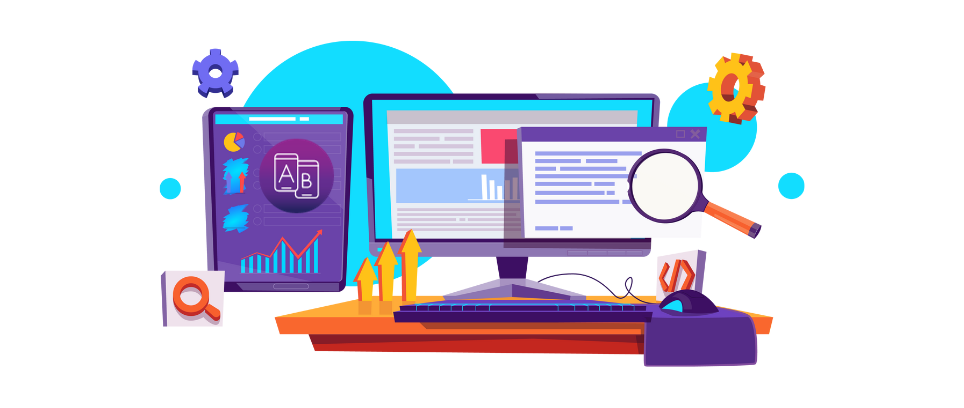Have you ever wondered what makes some websites, marketing campaigns, or user experiences stand out from the rest?
Why do some companies seem to effortlessly attract and retain customers while others struggle to make an impact?
The secret lies in the world of A/B testing – a powerful technique that can revolutionize your web design, marketing strategies, and user experience, propelling your business to new heights.
In a rapidly evolving digital landscape where competition is fierce and user expectations are higher than ever, it’s crucial to continually refine and optimize every aspect of your online presence. A/B testing is the key to achieving this, but before we delve into the depths of this transformative method, let’s ask a few exciting questions to pique your curiosity:
1. Why do some websites convert visitors into customers more effectively than others?
You’ve probably encountered websites that seem to effortlessly guide you toward making a purchase or taking a specific action. What’s their secret sauce, and how can you replicate it for your own site?
2. How can a single word change the trajectory of your marketing campaign?
Imagine sending out two versions of an email to your subscribers, with just one word altered. Could this tiny modification make a substantial difference in your click-through rates and conversions? A/B testing can provide the answers.
3. What if your website could adapt to individual user preferences in real-time?
Personalization is the buzzword in user experience today, but how do you know what changes will resonate with your audience? A/B testing can help you tailor your website dynamically for each visitor, delivering a customized experience that keeps them engaged and satisfied.
4. Can a color change lead to higher revenue?
Believe it or not, the color of a button, a headline, or a call-to-action can significantly impact user behavior. A/B testing can reveal the optimal color choices that drive conversions and revenue growth.
A/B testing, also known as split testing, is the scientific method for answering these questions and many more. It’s the process of comparing two versions of a web page, email, or marketing campaign to determine which one performs better. By systematically tweaking and testing various elements, you can make data-driven decisions that lead to improved outcomes.
The Anatomy of A/B Testing
Now that you’re intrigued, let’s dive deeper into the world of A/B testing and explore its components:
1. Hypothesis Creation
Every successful A/B test begins with a well-defined hypothesis. This is the educated guess about what you believe will improve your web design, marketing, or user experience.
It might be changing the color of a button, rewriting a headline, or adjusting the placement of a product image. The key is to make your hypothesis specific, measurable, and based on user behavior data.
2. Test Design
Once you have a hypothesis, you’ll need to design your A/B test. This involves creating two versions: the current version (A) and the modified version (B).
Ensure that the only difference between the two versions is the element you’re testing. This isolates the variable you want to analyze.
3. Randomization
To ensure the validity of your A/B test results, it’s crucial to randomize the presentation of versions A and B to your website visitors or email recipients. Randomization helps minimize bias and ensures that your results are representative of your entire audience.
4. Data Collection
During the test, data is collected on user interactions, such as clicks, conversions, bounce rates, and engagement metrics. Robust data collection tools are essential for accurate analysis.
5. Statistical Analysis
After running the test for a sufficient duration, you’ll perform statistical analysis to determine which version (A or B) produced better results. Statistical significance is a key factor here, as it tells you whether the observed differences are reliable or merely due to chance.
6. Implementation of Findings
Once you’ve identified a winning version, you can implement the changes on your website, in your marketing materials, or within your user experience design. This is where the real magic happens, as you start to see tangible improvements in your key performance indicators (KPIs).
A/B Testing in Action
Let’s take a closer look at some real-world scenarios where A/B testing can work wonders:
1. Website Optimization
A/B testing allows you to refine your website’s design, layout, and content. Whether it’s testing different product page layouts, experimenting with navigation menus, or fine-tuning your checkout process, A/B testing helps you create a website that’s user-friendly and conversion-focused.
2. Email Marketing
In the world of email marketing, tiny changes can have a big impact. A/B testing subject lines, email copy, images, and CTAs can help you boost open rates, click-through rates, and ultimately, conversions.
3. E-commerce
For e-commerce businesses, A/B testing can lead to substantial revenue increases. Testing product descriptions, pricing strategies, and even the color of “Buy Now” buttons can make the difference between abandoned shopping carts and completed purchases.
4. Content Engagement
A/B testing headlines, article lengths, and content formatting can help you engage your audience more effectively. By delivering content that resonates with your readers, you can increase time spent on your site and reduce bounce rates.
The Road to Success: A/B Testing Best Practices
Before you embark on your A/B testing journey, it’s essential to follow some best practices to ensure meaningful results and avoid common pitfalls.
Here are a few tips:
1. Set Clear Goals
Define what success looks like for your A/B test. Is it higher click-through rates, increased revenue, or improved user engagement?
2. Test One Variable at a Time
To pinpoint the cause of any improvements or setbacks, change only one element at a time in your A/B tests.
3. Collect Enough Data
Ensure that your test runs for a sufficient duration to gather statistically significant results. This prevents you from prematurely declaring a winner.
4. Segment Your Audience
Consider segmenting your audience based on demographics, behavior, or other factors to gain deeper insights into user preferences.
5. Continuously Iterate
A/B testing is an ongoing process. Continuously refine and optimize your website, marketing, and user experience based on what you learn from your tests.
A/B testing is not a one-size-fits-all solution, but rather a powerful toolkit that can transform your web design, marketing, and user experience from good to exceptional. By asking the right questions, formulating hypotheses, and rigorously testing your assumptions, you can unlock the potential for continuous improvement and growth in the digital age.
In the ever-evolving digital landscape, those who embrace A/B testing as a core strategy are the ones who will stay ahead of the competition and consistently deliver outstanding experiences to their audience.
So, are you ready to embark on your A/B testing journey and optimize your way to success?
The answers to your questions await, and the possibilities are endless.
 Pin
PinJoin Accredian’s Executive Program in Data Science & AI today and unlock the future of technology and innovation. Seize this opportunity now!






